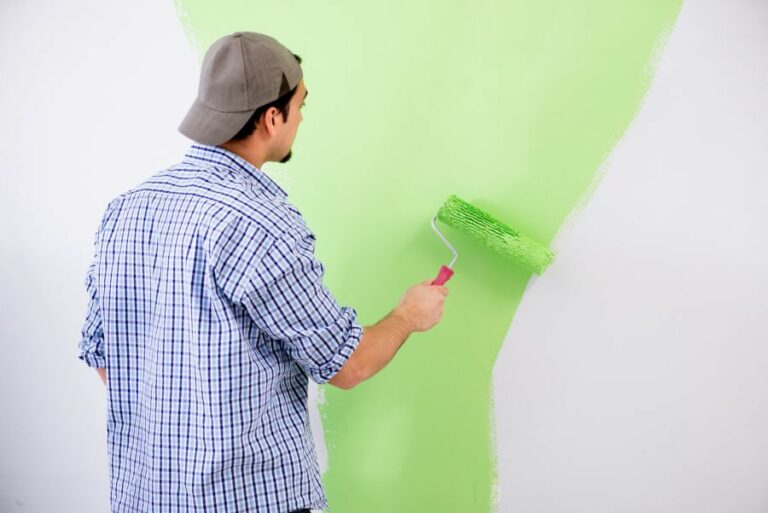Indoor Painting With Oil-Based Options, 25 Things You Should Know
Are you looking to refresh the interior of your home with a new coat of paint? Knowing which paint type is best for achieving the desired result while ensuring durability and easy maintenance is essential. Oil-based paints can offer several advantages while painting indoors, and understanding their benefits will enable you to make an informed decision confidently.
Indoor painting with oil-based options:
Oil-based paints offer durability, ease of application, and superior leveling properties, making them ideal for indoor surfaces that require a smooth finish and resist moisture, stains, and wear. Available in various colors and finishes, they provide long-lasting results when applied properly with appropriate tools and ventilation. However, due to higher VOC content, consider local regulations and low-VOC alternatives for environmental and health concerns.

Dive into the world of indoor painting with oil-based options and discover innovative techniques, surface preparation, and finishing touches. Explore the advantages and potential challenges of oil paints in your interior projects. Are you ready to unlock the secrets of oil-based painting? Read on!
Contents
- 1 Interior Painting Using Oil-Based Alternatives
- 2 Evaluating Oil-Based Paint for Indoor Use
- 3 The Continued Use of Oil-Based Paint by Professionals
- 4 Applications for Oil-Based Paint in Your Home
- 5 Identifying Common Oil-Based Paints for Houses
Interior Painting Using Oil-Based Alternatives
• Advantages of Oil-Based Paints
When it comes to indoor painting, oil-based paints offer several advantages over their water-based counterparts. Oil-based paints are known for their durability, ease of application, and superior leveling properties.
This produces a smoother finish, making them an ideal choice for trim, doors, and cabinets where appearance and longevity are important.
– Durability and Resistance
Oil-based paints excel in areas with high traffic or wear, such as kitchens and bathrooms, as they are more resistant to moisture and stains. Moreover, they provide excellent adhesion on surfaces, resulting in less chipping and peeling.
This makes oil-based paints suitable for interior surfaces that need to withstand regular cleaning and scrubbing, such as baseboards and moldings.
– Time-Tested Results
Due to their proven performance and long-lasting results, oil-based paints have been a popular choice among professional painters and DIY enthusiasts for years. The slow-drying nature of oil-based paints also allows for better flow and leveling, ensuring a smooth and professional-looking finish.
– Vast Color Range
Oil-based paints offer a wide range of colors and finishes, including glossy, semi-gloss, and satin. This provides homeowners with ample choices for achieving the desired look and feel for their space.
• Application Tips for Oil-Based Paints
– Surface Preparation
To ensure a successful indoor painting project, thorough surface preparation is crucial. Begin by removing dirt, grease, and mildew from the surfaces using a mixture of warm water and mild detergent. Rinse with clean water and allow the surfaces to dry completely.
Any loose or peeling paint should be scraped away using a paint scraper, followed by sanding to create a smooth surface for the new paint to adhere properly. Lastly, apply a high-quality oil-based primer to seal and protect the surface, ensuring a longer-lasting paint job.
– Choosing the Right Tools
Selecting the appropriate tools for your painting project can significantly affect the ease of application and the final outcome. For oil-based paints, it’s essential to use brushes and rollers specifically designed for use with oil-based products.
These are typically made with natural bristles like China bristle or ox hair. Rollers with a medium nap (3/8 to 1/2-inch) are recommended for most interior surfaces.
– Adequate Ventilation
When working with oil-based paints indoors, ensuring proper ventilation is crucial. Open windows and doors, use exhaust fans, and take regular breaks to minimize exposure to paint fumes.
– Drying Time and Cleanup
Oil-based paints take longer to dry than their latex counterparts, with an average drying time of up to 24 hours. Although this allows for better leveling and a smoother finish, it also means that drips and brush marks may take longer to correct.
Clean-up after oil-based paint projects requires solvents like mineral spirits or paint thinner, as water alone will not suffice. Properly dispose of any used solvents and paint-soaked rags, as these can be flammable and hazardous.
• Environmental and Health Considerations
It’s important to note that oil-based paints have a higher volatile organic compound (VOC) content, which can contribute to air pollution and have adverse health effects.
Many states and municipalities have introduced regulations limiting the use of high-VOC products, so it’s essential to verify local regulations before deciding to use oil-based paints.
If you’re concerned about the environment and your health, low-VOC and zero-VOC alternatives are now available on the market. These products offer many of the advantages of traditional oil-based options without the downsides associated with high-VOC content.
• Conclusion
Oil-based paints offer a durable and timeless finish for indoor painting projects. When used correctly and with proper precautions, they can provide a beautiful and lasting result for your home’s interior.
Before embarking on your painting project, research local regulations pertaining to oil-based products, and consider low-VOC alternatives if environmental impact is a concern.
For further information on oil-based paint options and their applications, the Environmental Protection Agency is an excellent resource to consult.
Evaluating Oil-Based Paint for Indoor Use
When choosing paint for indoor spaces, there are numerous factors to consider. One such factor is the type of paint: oil-based or water-based.
• Benefits of Oil-Based Paint for Indoor Use
– Durability and Resistance
Oil-based paints are known for their durability and resistance to wear and tear. These qualities make them ideal for high-traffic areas such as door frames, window sills, and trim, where a long-lasting finish is required.
Furthermore, oil-based paints are less prone to chipping, peeling, or flaking than their water-based counterparts.
– Smooth and Glossy Finish
Another notable advantage of oil-based paints is their smooth and glossy finish, which is challenging to achieve with water-based paints.
The slow-drying nature of oil-based paint enables the creation of a seamless surface with minimal brush marks, making it an excellent option for those looking to achieve a professional finish.
– Excellent Adhesion
Oil-based paint adheres well to a variety of surfaces, including wood, metal, and previously painted surfaces. Consequently, it prevents the need for excessive prep work, such as priming, which can save time and effort.
• Limitations of Using Oil-Based Paint Indoors
– Harmful Fumes and VOCs
One of the primary concerns associated with using oil-based paint indoors is the release of harmful fumes and volatile organic compounds (VOCs). Exposure to these fumes can cause headaches, dizziness, and respiratory issues, especially during the application and drying processes.
The Environmental Protection Agency (EPA) urges caution when using products with high VOC levels and recommends proper ventilation to minimize potential health risks.
– Strict Regulations and Environmental Impact
Due to the environmental and health concerns associated with oil-based paints, strict regulations govern their usage in many regions. Consequently, manufacturers have shifted their focus toward low-VOC or VOC-free water-based alternatives.
Additionally, the disposal of oil-based paint is often subject to strict guidelines due to its impact on the environment, making it less convenient for the average homeowner.
– Difficulty in Cleanup and Storage
Oil-based paint requires more care during cleanup and storage than water-based paints. For instance, brushes and other painting tools must be cleaned with mineral spirits or other solvents rather than water.
Moreover, oil-based paint is more likely to develop thick skin on the surface when stored, rendering it unusable.
• Alternatives to Oil-Based Paint for Indoor Use
– Water-Based Paints
Given the limitations associated with oil-based paint, many homeowners and professionals are opting for water-based alternatives such as acrylic and latex paint. These offer easier cleanup and lower VOC levels without compromising finish and durability.
Additionally, advancements in paint technology have led to water-based enamels that closely mimic the glossy sheen of traditional oil-based paint.
– Low-VOC or VOC-Free Paints
To further mitigate traditional paint’s health and environmental concerns, low-VOC or VOC-free alternatives are now available on the market. These options provide peace of mind without sacrificing quality and performance.
• Final Thoughts and Personal Recommendations
In conclusion, oil-based paint can be suitable for indoor use, particularly when a durable, smooth, and glossy finish is desired. However, the potential health risks and environmental concerns, coupled with the availability of high-performing alternatives, make it less appealing for most indoor applications.
From personal experience, I recommend exploring water-based alternatives for indoor spaces, especially those with limited ventilation. Additionally, if a glossy finish is desired, consider using water-based enamel products, which provide an oil-like finish with lower VOC levels and easier cleanup.
Finally, for those committed to using oil-based paint indoors, ensure proper ventilation during and after application, and adhere to all regional regulations regarding its use and disposal.
The Continued Use of Oil-Based Paint by Professionals
If you are curious whether oil-based paint is still being used by painters today, the answer is: yes. Oil-based paint continues to be a popular choice for artists and professionals alike, retaining its enduring appeal throughout history.
• Advantages Of Oil-Based Paints
Oil-based paints offer several advantages, making them an attractive choice for artists and professionals.
– Rich Colors And Flexibility
The high degree of pigment saturation in oil-based paints allows for deep, rich colors that create vibrant and powerful art. Additionally, oil paint’s slow drying time allows artists to blend colors directly on the canvas, creating smooth gradients and enabling various texture effects.
– Durable And Resistant
Oil-based paints are known for their durability and resistance to wear and tear. This makes them a preferred choice for high-traffic areas or objects that are exposed to outdoor elements. Artworks crafted with oil-based paint have a higher chance of staying vibrant and undamaged over time.
Conservation Issues For Oil-Based Paints (nga.gov)
• Disadvantages Of Oil-Based Paint
Despite their various benefits, oil-based paints present some challenges that artists must consider before using them.
– Environmental And Health Concerns
Oil-based paint contains volatile organic compounds (VOCs), which vaporize into the air as they dry. These compounds are hazardous to human health and the environment. As a result, many artists and professionals are adopting low-VOC alternatives, such as water-based acrylics and latex paints.
– Difficult Clean-Up
Artists and professionals should be aware that oil-based paints can be challenging to clean up. While water-based paints can be easily removed with soap and water, oil-based paints require the use of solvents, like mineral spirits or turpentine, which are toxic and give off strong odors.
• Oil-Based Paint-Intrinsic Versatility
Understanding the variety of ways oil-based paint can be utilized by artists and for a wide range of applications.
– Professional Uses
While many artists favor oil paint for its richness and versatility, it is also widely used by professionals for various applications, including signage, furniture restoration, and renovation projects. The durability and resistance of oil-based paints make them ideal for these situations.
– Industrial And Commercial Applications
Oil-based paints are highly valued for their robust finish in industrial and commercial settings, providing ample protection on metal surfaces, machinery, and exterior structures. This helps protect these heavily used objects from the wear and tear they typically experience.
• Precautions When Using Oil-Based Paint
Implementing precautions when using this type of paint will ensure safety and an optimal painting experience.
– Ventilation And Safety Gear
Due to the toxic nature of solvents involved in oil-based paint, it is crucial to work in a well-ventilated space and use safety gear like masks and gloves. This protects the artist and any bystanders from the fumes produced.
– Disposal
Lastly, proper disposal of oil-based paint waste and cleaning materials should be practiced as part of an eco-friendly approach to reduce environmental impacts.
• Real-World Artists And Oil-Based Paint
Several prominent contemporary artists continue to use oil-based paint in their work, defying the claims that this medium is an antiquated technique. Some examples include the following:
The ongoing use of oil-based paints by notable painters demonstrates this artistic medium’s enduring appeal and significance.
• Final Verdict
The reality is that the use of oil-based paint, while facing challenges regarding its environmental and health impacts, continues to be a go-to choice for many artists and professionals.
Its ability to produce rich colors, durability, and versatile application make oil-based paint a timeless choice in the world of painting.
Nevertheless, it is essential to acknowledge the potential consequences and apply safety measures when using oil-based paint to ensure a safe and enjoyable painting experience.
Applications for Oil-Based Paint in Your Home
Oil-based paint, also known as alkyd paint, is a versatile and durable option for a variety of surfaces. It is known for its high-quality finish, resistance to moisture and chemicals, and excellent adhesion properties.
• Recommended Surfaces for Oil-Based Paint
Oil-based paint can be used on a wide range of surfaces, but certain materials and projects are more suitable than others. I will cover some of the most popular and recommended surfaces to paint using oil-based paint.
– Wood
Wood is a popular and suitable surface for oil-based paint. Oil paints adhere well to wood due to the material’s porous nature. Oil-based paint can protect wood from moisture, mildew, and wear, making it ideal for exterior and interior applications. Examples include:
- Furniture
- Trim and molding
- Doors and windows
- Wooden decks and fences
- Wooden art projects
– Metal
Oil-based paint is an excellent choice for metal surfaces, providing durability, protection against rust, and an attractive finish. Common metal surfaces that can be painted with oil-based paint include:
- Iron and steel (after applying a rust-inhibiting primer)
- Aluminum surfaces (with an appropriate primer)
- Galvanized metal (with a galvanized metal primer)
- Metal furniture, fixtures, and ornaments
- Railings and fences
– Masonry
Masonry surfaces, such as brick, stone, and concrete, can be painted with oil-based paint. This paint type provides excellent protection against moisture and weather, making it suitable for both interior and exterior applications. Some examples of masonry surfaces include:
- Brick walls and fireplaces
- Concrete floors and walls
- Stone walkways and patios
- Cinder block walls
- Stucco surfaces
– Canvas and Other Surfaces
Oil-based paints are popular among artists for their vibrant colors and slow drying time, making them suitable for various artistic styles and techniques. Surfaces that can be painted with oil-based paint include:
- Traditional artist canvas
- Linen, cotton, or synthetic fabric
- Paper (specifically designed for oil paint)
- Wooden panels
- Glass (with proper surface preparation)
• Special Effects and Techniques
Although not as common, oil-based paints can create unique textures and finishes on various surfaces. The following are some examples of special effects and techniques that can be achieved using oil-based paint:
– Faux Finishes
Oil-based paint can be used to create a wide range of faux finishes, such as marble, wood grain, and patina. These effects can add depth and interest to walls, furniture, and other surfaces, elevating their appearance and creating a sophisticated, custom look.
– Glazing
Oil-based paint is often used for glazing, a technique that involves applying a thin layer of transparent paint over a previously painted surface to create depth, contrast, and luminosity.
This technique is commonly used by artists, but it can also be applied to walls, furniture, or other surfaces for a unique and refined finish.
– Impasto
Impasto is a technique commonly used by artists, which involves applying thick layers of oil paint to create texture and dimension on the canvas. This technique can also be used on furniture and other surfaces, adding visual interest and tactile quality.
• Safety and Environmental Considerations
It is important to note that oil-based paints contain volatile organic compounds (VOCs), which can contribute to air pollution and may cause health issues. Always ensure proper ventilation when using oil-based paint, wear a respirator mask, and responsibly dispose of paint and paint-related waste.
Furthermore, many states and municipalities have regulations restricting the use of oil-based paint due to its environmental impact. Before starting any painting project, check your local regulations and consider lower-VOC alternatives, such as water-based paint or other eco-friendly options.
In conclusion, oil-based paint offers versatility and durability for many surfaces, such as wood, metal, and masonry. Choosing the right primer and proper surface preparation is important for a successful outcome.
The paint can also be used to create unique finishes and artistic effects, making it a valuable medium for both functional and creative applications. Always consider safety and environmental considerations when using oil-based paint, and follow local regulations regarding usage and disposal.
Identifying Common Oil-Based Paints for Houses
Oil-based house paint, often referred to as alkyd paint or simply as oil paint, has been popular for decades due to its durability and glossy finish. It is particularly useful for high-traffic areas, such as trim, doors, and windows, where tougher, more water-resistant paint is needed.
• The Composition of Alkyd Paint
Alkyd paint is made of an alkyd resin, which is a synthetic polymer derived from vegetable oils combined with various solvents and pigments. The term “oil paint” comes from the inclusion of drying oils, such as linseed oil, which are mixed with the resin and other components.
These drying oils are responsible for oil-based paint’s slow drying time and characteristic hardness.
– Alkyd Resin
Alkyd resin, the main component of oil-based paint, is a polyester that is derived from the reaction between an alcohol and a fatty acid.
The resin’s properties, including gloss, durability, and flexibility, can be fine-tuned through variations in the specific alcohol and fatty acid used and the proportion of these components (Introduction to Alkyd Resins).
– Solvents and Pigments
Solvents, such as mineral spirits or turpentine, are added to alkyd resins to make the paint easier to apply and to control the drying time. Pigments are what give the paint its color and can come from a variety of sources, both natural and synthetic.
In addition, other additives may be present in the paint to improve its properties, such as leveling agents, which can help the final finish be smooth and free of brush marks.
• Benefits of Oil-Based House Paint
Oil-based paint has several advantages over other types of paint. These qualities have made it popular for experienced painters and homeowners alike.
– Improved Durability
Oil-based paint has a higher concentration of resin, which makes the final finish much more resistant to wear and tear. This improved durability is especially useful for high-traffic areas, such as doors and trim, that are likely to see more frequent contact and exposure to moisture.
– Glossy Finish
Another benefit of oil-based paint is its naturally glossy finish. These paints are capable of producing a smooth, high-gloss sheen that is difficult to achieve with water-based paints. This makes oil paint ideal for achieving a polished and professional look.
– Superior Adhesion
Oil-based paint adheres well to a variety of surfaces, including metal, wood, and previously painted surfaces, even those covered with a layer of latex paint. This strong adhesion means that oil-based paint is less likely to chip or peel away over time.
• Drawbacks of Oil-Based House Paint
Despite its many benefits, oil-based paint also has some downsides. It’s important to be aware of these when choosing the right paint for your home.
– Longer Drying Time
Oil paint takes significantly longer to dry than water-based paint, which can be inconvenient for homeowners and painters alike.
Depending on factors such as humidity and temperature, drying time can take anywhere from 8-24 hours, which means you might have to plan your painting schedule accordingly.
– Strong Odor and VOCs
Oil-based paint has a strong smell due to the solvents used. Additionally, it has higher levels of volatile organic compounds (VOCs) than water-based paints, which can be harmful to indoor air quality (EPA – Volatile Organic Compounds). Proper ventilation during and after the painting is important to mitigate these concerns.
– Clean Up
Cleaning up after using oil-based paint can be more challenging, as water cannot be used to clean brushes and other tools. Instead, you’ll need to use a solvent such as mineral spirits or turpentine.
• How to Apply Oil-Based House Paint
Proper application techniques are crucial to achieving a smooth, even finish with oil-based paint.
– Surface Preparation
Before painting, it’s essential to prepare the surface properly. Remove any loose or peeling paint, and sand the surface to ensure proper adhesion. Be sure to clean the surface thoroughly, removing any dust, dirt, or grease which can prevent the paint from adhering properly.
– Priming
Priming is an important step when using oil-based paint, especially on porous surfaces or with stains. Priming seals the surface ensures an even finish, and can help prevent stains from bleeding through into the final coat of paint.
– Application
Apply the paint using a high-quality brush, using long and smooth strokes. Be careful not to overload the brush, as this can lead to dripping and uneven coverage. It’s generally best to apply multiple thin coats rather than one thick coat, as this can help promote a smooth and even finish.
– Drying and Curing
Allow the paint to dry completely between coats, which can take anywhere from 8-24 hours, depending on conditions. Be aware that oil-based paint can take up to 30 days to cure fully, so handle painted surfaces gently during this time to avoid damage to the finish.
• Conclusion
Oil-based house paint, or alkyd paint, is a durable and glossy option for homeowners who want a long-lasting finish in high-traffic areas. Though it has a longer drying time and a stronger odor than water-based paint, its superior adhesion and durability make it a popular choice for certain applications.
Proper surface preparation, priming, application techniques, and adequate drying and curing time are critical to achieving a professional-looking result with oil-based paint.







